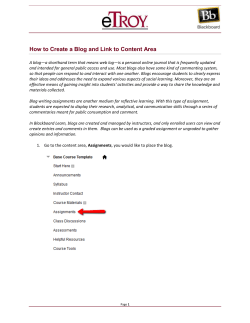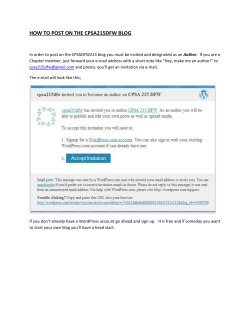
Online Collaboration Tools
Online Collaboration Tools
With whom do people connect?
What are the different reasons people connect with
one another?
How do you communicate and connect with other
people, and with the world?
How do you like to connect with information?
Collaboration is an organizational capability that will
become increasingly vital to business success and,
further, that “digital collaboration” - the
use of technologies to enable efficient and valuable
connections among people and information represents the area of IT with the greatest potential
for improving business performance in the next five
years.
What are the best ways we can
collaborate and work together digitally?
What makes communication and collaboration difficult?
What makes it necessary?
What is the definition of
“Collaborative Tools”?
A collaboration tool is something that
helps people collaborate. The term is often
used to mean collaborative software, but
collaboration tools were being used before
computers existed. A piece of paper, for
example, can be used as collaboration tool.
Collaborative Tools
Collaborative tools available
So many tools so little time....
Collaborative Tools
Topics
• Online Meeting Software
• Communications Options
• Collaborative Project Solutions
Online meeting Software - Overview
Online Meeting Software – Common
Features
Desktop Sharing
Invitation Features
InstantMessaging/Chat
Whiteboard
Recording/Archives
Multiple Presenters
Teleconferencing or VoIP
Video Conferencing
Online Meeting Software - Considerations
download software
log in software
Online Meeting Software – Considerations
In web meetings your audience will effect
everything from the software you choose to
the price you may have to pay for it.
Online Meeting Software – Considerations
(cont)
When planning your online meeting keep
the presentation location and audience
location in mind.
Low Cost Online Meeting Software
• YuuGuu - http://www.yuuguu.com/
Yuuguu is great for web conferencing and
screen sharing
• Vyew - http://vyew.com
Vyew is a relatively new collaboration
platform that can be used for webinars,
online conferences, and real-time learning
and instruction. No installation is required
and all activity can be tracked and logged.
Paid online Meeting Software
• GoToMeeting - http://www.gotomeeting.com/fec/
GoToMeeting is the extremely simple, extraordinarily
powerful way to hold unlimited online meetings with up to
25 attendees
• AdobeConnect http://www.adobe.com/products/adobeconnect.html
An enterprise web conferencing software that provides
secure web meeting, eLearning, and webinar solutions
• WebEx - http://www.webex.com/
A web conferencing combines file and presentation
sharing with voice, HD video and new Meeting Spaces
Paid online Meeting Software (cont)
• ooVoo - http://www.oovoo.com
ooVoo offers a free 2-way video chat service
and a 6-way text chat. The site can also be
used to record and send short video
messages.
• Yugma - https://www.yugma.com/
Yugma, the leading Web collaboration service
that lets people connect instantly over the
Internet to share content and ideas using any
application or software, is the latest addition to
Skype Extras
Communication Options
• Skype
– http://www.skype.com
Skype is a freemium voice-over-IP service and
instant messaging client developed by the Microsoft
Skype Division
• GoogleVoice
– https://www.google.com/voice/
Google Voice enhances the existing capabilities of
your phone
Scheduling
• Doodle - http://doodle.com/
Doodle is a free Internet calendar tool for time
management, and coordinating meetings.
– Free
– Paid account provides additional features
Collaborative project management
• Collaborative project management is a
method used to plan, coordinate, control, and
monitor distributed and complex projects. It
enables project teams to collaborate across
departmental, corporate, and national
boundaries and to master growing project
complexity.
Collaborative Projects
• Microsoft Sharepoint - http://sharepoint.microsoft.com
• Zoho - http://www.zoho.com/
• Google Docs - https://docs.google.com/
Relating in Real-Time
• Synchronous tools enable real-time
communication and collaboration in a "same time-different place"
mode. These tools allow people to connect at a single point in time, at
the same time. Synchronous tools possess the advantage of being
able to engage people instantly and at the same point in time. The
primary drawback of synchronous tools is that, by definition, they
require same-time participation -different time zones and conflicting
schedules can create communication challenges. In addition, they
tend to be costly and may require significant bandwidth to be efficient.
Relating in Real-Time
Tool
Useful for
Drawbacks
Audio conferencing
Discussions and dialogue
Cost, especially when international
participation is involved
Web conferencing
Sharing presentations and information
Cost, bandwidth; may also require audio
conferencing to be useful
Video conferencing
In-depth discussions with higher-touch
interactions
Cost, limited availability of video conferencing
systems
Chat
Information sharing of low-complexity
issues
Usually requires typing, "lower touch"
experience
Instant messaging
Ad hoc quick communications
All users must use compatible system, usually
best for 1:1 interactions
White boarding
Co-development of ideas
Cost, bandwidth; may also require audio
conferencing to be useful
Application sharing
Co-development of documents
Cost, bandwidth; may also require audio
conferencing to be useful
Relating in Real-Time
• Asynchronous tools enable
communication and collaboration over a period of time through
a "different time-different place" mode. These tools allow people
to connect together at each person's own convenience and own
schedule. Asynchronous tools are useful for sustaining dialogue
and collaboration over a period of time and providing people
with resources and information that are instantly accessible, day
or night. Asynchronous tools possess the advantage of being
able to involve people from multiple time zones. In addition,
asynchronous tools are helpful in capturing the history of the
interactions of a group, allowing for collective knowledge to be
more easily shared and distributed. The primary drawback of
asynchronous technologies is that they require some discipline
to use when used for ongoing communities of practice (e.g.,
people typically must take the initiative to "login" to participate)
and they may feel "impersonal" to those who prefer highertouch synchronous technologies.
Relating in Real-Time
Tool
Useful for
Drawbacks
Discussion boards
Dialogue that takes place over a period of time May take longer to arrive at decisions or conclusions
Web logs (Blogs)
Sharing ideas and comments
May take longer to arrive at decisions or conclusions
Messaging (e-mail)
One-to-one or one-to-many
communications
May be misused as a "collaboration tool"
and become overwhelming
Streaming audio
Communicating or teaching
Static and typically does not provide option to answer
questions or expand on ideas
Streaming video
Communicating or teaching
Static and typically does not provide option to answer
questions or expand on ideas
Narrated slideshows
Communicating or teaching
Static and typically does not provide option to answer
questions or expand on ideas
Relating in Real-Time
Tool
"Learning objects"
(Web-based training)
Useful for
Teaching and training
Drawbacks
Typically does not provide option to answer
questions or expand on ideas in detail
Document libraries
Managing resources
Version control can be an issue unless check-in
/ check-out functionality is enabled
Databases
Managing information and knowledge Requires clear definition and skillful
administration
Web books
Teaching and training
Not dynamic and may lose interest of users
Surveys and polls
Capturing information and trends
Requires clear definition and ongoing
coordination
Shared Calendars
Coordinating activities
System compatibility
Web site links
Providing resources and references
May become outdated and "broken"
Social Networking
• A social networking service is an
online service, platform, or site that
focuses on facilitating the building of
social networks or social relations
among people who, for example,
share interests, activities,
backgrounds, or real-life connections.
Professional Network Service
• A professional network service is a type of
social network service that is focused solely
on interactions and relationships of a
business nature rather than including
personal, nonbusiness interactions.
• Professional networking always has a
purpose and a goal which is ultimately to
move forward in one's career.
5 Rules for Professional Social
Networking Success
•
•
•
•
1. Know Your Platforms
2. Customize Everything
3. Ask for Something Specific
4. Take It Offline Whenever
Possible
• 5. Say "Thank You"
Professional Social Networks
Biznik – A community of
entrepreneurs and small
businesses dedicated to helping
each other succeed.
cmypitch.com – A business
website for UK entrepreneurs
to get quotes, advice and
more.
Professional Social Networks
Cofoundr – A community for
entrepreneurs, programmers,
designers, investors, and other
individuals involved with
starting new ventures.
E.Factor – An online
community and virtual
marketplace designed for
entrepreneurs, by
entrepreneurs.
Professional Social Networks
Ecademy –A business
network for creating contacts
and sharing knowledge.
Entrepreneur Connect – A
community by
Entrepreneur.com where
professionals can network,
communicate, and collaborate
with others.
Professional Social Networks
Fast Pitch – A business
network where professionals
can market their business and
make connections.
Focus – A community
focused on helping
business decision makers
and IT professionals
make decisions.
Professional Social Networks
JASEzone – A professional
community where you can find
potential clients and business
partners.
LinkedIn – A professional
network that allows you to
be introduced to and
collaborate with other
professionals.
Professional Social Networks
Networking for
Professionals – A business
network that combines
online business networking
and real-life events.
PartnerUp – A community
connecting small business
owners and entrepreneurs.
Professional Social Networks
PerfectBusiness – A
network of entrepreneurs,
investors and business
experts that encourages
entrepreneurship and
mutual success.
Plaxo – An enhanced address
book tool for networking and
staying in contact.
Professional Social Networks
Ryze – A business
networking community that
allows users to organize
themselves by interests,
location, and current and
past employers.
StartupNation – A
community focused on
the exchange of ideas
between entrepreneurs
and aspiring business
owners.
Professional Social Networks
Upspring – A social networking
site for promotion and social
networking.
XING – A European
business network with
more than 7 million
members.
Professional Social Networks
Young Entrepreneur – A forumbased site for entrepreneurs and
small business owners who are
passionate about promoting
business for themselves and
others.
Ziggs – A professional
connection portal
founded on the principles
of professionalism and
respect.
Blogs
• A blog (a contraction of the words web log) is a
discussion or informational site published on the World
Wide Web and consisting of discrete entries ("posts")
typically displayed in reverse chronological order (the most
recent post appears first). Until 2009 blogs were usually
the work of a single individual, occasionally of a small
group, and often covered a single subject. More recently
"multi-author blogs" (MABs) have developed, with posts
written by large numbers of authors and professionally
edited
Blog Features
A - The entry title- This is the title of the
blog entry. B - The date of the entry
C - The permalink D-RSS Feeds EComments
B
A
C
E
D
Why Blog?
• Why blog?
– To make regular updates about assignments, events, and
anything going on in a class/project;
– Anything you post will be instantly accessible;
– They help with the facilitation of online discussions and
collaboration.
– Create class/project publication
– Replace “printed” materials
Why Blog?
• Get students/colleagues to share their work and
thoughts;
• Integrate video, podcasts, and other media;
• Get feedback or gather information.
• Use comments, forums, or even customized forms
to collect feedback, survey data, or ask anyone for
input or ideas.
Blogs
• Blogs are web-based
– No client software to download and learn
– Update from any internet-connected device
• Easy to use
– Don’t need to know code or use HTML
– Don’t need to use FTP
• Not solitary
– Community of blogs and bloggers make up a vast social
network
Blogs vs. Wikis
• Objective
– Blogs are a way to share personal information, a way for the
owner(s) to express themselves to their target audience
– Wikis are a means of sharing and editing data [ideas, text,
photographs] for the creation of collaborative knowledge
• Content creation and control
– Blog content creating and control falls to the owner.
– Wiki content creation and control falls to the audience [although
there is an administrator]
Definitions
• Blog: a web log.
• Blogger: Someone who creates and maintains a blog.
• Blogging: The process of creating and maintaining a
web log.
• Blogshpere/Blogosphere: The totality of blogs; a
community or social network of blogs.
• Blogroll: A list of blogger’s favorite blogs, usually
placed on the side of that blogger’s blog.
Pin It
Pin It
How to Ensure Your Future Blog
Posts Are Popular
#1: Monitor
Influencer Social
Channels
#2: Take a Hint From
Your Community
Pin It
Pin It
How to Ensure Your Future Blog
Posts Are Popular
#3: Check Your Top
Posts on Facebook
#4: Measure Your
Tweet Impact
Social Norms & Behaviors
Social norms are best described as the rules set in place to define
what is considered to be appropriate behaviors and values.
The Future of Social Media
Social Listening
1) You don’t need a social media
marketing program to use social
listening
2) You get what you pay for (and that’s
OK)
3) Consumers aren’t sure how they feel
about social listening
Get Better Results: 3 Tips for Smarter
Social Listening
• Know Why You’re
Listening | Social
Listening for Smarter
Business
• Narrow Your Searches |
Social Listening &
Search Modifiers
• Look at the Word Cloud
First | Social Listening &
Data Visualization
52
Computer ethics
◦ Take basic ethical principles and applies them to daily
computer use
Ethical principle
◦ Justification used to determine whether a rule or act
is morally right or wrong
◦ Uses standards that promote trust, fairness, good
behavior, and kindness
53
Follow
your
school’s code
of conduct:
◦ Acceptable-use
policy (code of
conduct)—set of
rules to follow when
using computers at
school or a place of
business
54
Rules
for using school and
business computers:
◦ Respect yourself
Don’t give account passwords to others
Don’t use the Internet inappropriately
◦ Respect others
Do not threaten or harass anyone
Share computer resources
Act professionally
55
Rules (con’t.)
◦ Respect academic integrity
Cite text copied from the Internet
Obtain permission to use pictures from the Internet
Don’t copy or distribute software unless you have
permission to do so
◦ Classroom computer etiquette is an important academic
issue
56
Ten
Commandments for
Computer Ethics—Background
◦ Developed by the Computer Ethics Institute of the
Brookings Institution
◦ Applicable for computer programmers, system
designers, and all computer users
57
Ten Commandments:
1. Thou shalt not use a computer to harm other people
2. Thou shalt not interfere with other people’s computer
work
3. Thou shalt not snoop around in other’s computer files
4. Thou shalt not use a computer to steal
5. Thou shalt not use a computer to bear false witness
58
Ten Commandments (con’t.):
6. Thou shalt not copy or use proprietary software for
which you have not paid
7. Thou shalt not use other’s computer resources without
authorization or proper compensation
8. Thou shalt not appropriate other’s intellectual output
9. Thou shalt think about social consequences of the
program you are writing or system you are designing
10. Thou shalt always use a computer in ways that ensure
consideration and respect for your fellow human
beings
Copyright © 2012 Pearson Education, Inc. Publishing as Prentice Hall
59
Netiquette
◦ Guidelines for using the
Internet
◦ More respectful
environment
◦ Discussion Forums
Postings should be
helpful or ask question
Never post in anger
60
Netiquette
(con’t.)
◦ E-mail
Check daily
E-mail is not private; be professional
◦ Instant Messages
Ideal for brief conversations
Don’t share bad news or major announcements
◦ Chat Rooms
Follow rules
Respect others; avoid foul language
61
Video gaming
◦ Growing
◦ Psychologists are not in agreement regarding the
effects of playing violent computer video games
Are becoming more violent
62
Employees—should not conduct personal
business on computers at work
Businesses should protect data
◦ From being lost or damaged and from inaccuracies and
misuse
Backup procedures
Continuous backups
63
Codes of conduct
◦ ACM-Association for Computing Machinery
◦ Institute for Certification of Computing
Professionals
Code of ethics for computer professionals are:
◦ Protecting human life
◦ Safeguarding others from harm or injury
64
Plagiarism
◦ Use of another’s ideas,
writings, or intellectual
property without
permission; unethical
and illegal
◦ Practiced for a long
time; it’s now easier—
because of the Internet
65
Copyright infringement
◦ When copyrighted material is plagiarized
Fair use
◦ Allows limited use of copyrighted material for research,
education, and commentary
◦ Brief selection for purpose of commentary, parody, news
reporting, research, and education
◦ Do not compromise the commercial value of the original
work
66
Libel
◦ Publication of false statements about a person or
business that results in injury to the person or business
Ease of computer use increases cases of libel
Posting a document on the Internet is publishing it
Be sure that anything you publish is true
Copyright © 2012 Pearson Education, Inc. Publishing as Prentice Hall
67
Software piracy
Software license
◦ Copying or distributing
copyrighted software
◦ Industry loses billions a
year
◦ Grants the right to back
up and install the
software
◦ Determines how many
computers
◦ Making copies for others
is illegal
68
Public domain software
◦ Free to users
◦ May be copied and modified
Shareware
◦ Users may use during a trial or evaluation period
◦ Users must buy the software to continue use
Registration fee
69
General Public License (GPL)
◦ Under the auspices of the Free Software Foundation
◦ Users may copy, use, and modify as long as software is not
sold
Site license
◦ Contract that permits the installation of software on multiple
computers at a reduced cost
Copyright protection schemes
◦ Thwart illegal use of programs
Software becoming machine dependent
70
Illegal:
◦ To use shareware past expiration date without paying
registration fee
◦ To violate terms of software license
◦ To make copies of site-licensed programs for home
◦ To give or sell copies of commercial software to others
◦ To incorporate all or part of GPL program offered for
sale
Protect yourself
◦ Make sure you have a product registration key
71
File Sharing
◦ May result in fines or jail
terms
◦ Refers to either
downloading copyrighted
files or uploading the files
to share
Lost income, loss of jobs,
earnings, and tax revenue
72
© Copyright 2025









